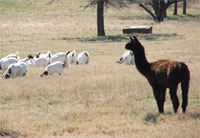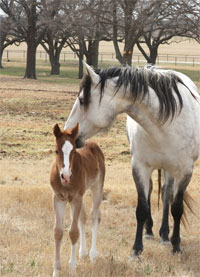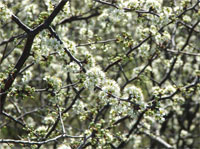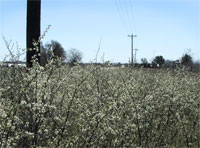Native Son – March, 2010
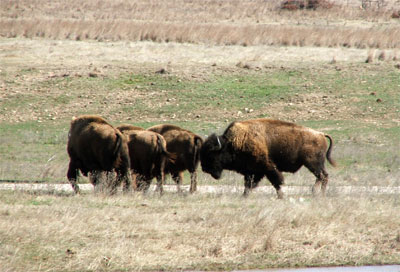
Scenery en route to the catfish house included this Parker County bison ranch. Photos by Steven Chamblee.
Road Trip to the Catfish House
The morning after: The sun is shining brightly and a brisk breeze inspires my jeans to dance, upside down, upon the clothesline. A single mockingbird is singing its song with such power and gusto that you’d think he’d pass out from all the effort. I look around the garden: a few daffodils wave cheerily, the southern sugar maple buds are swollen, and three pairs of flip-flops still dangle from the mesquite tree, where they have hung since my 50th birthday bash back in September. By all accounts, a perfectly lovely morning in late winter (never mind the calendar; the mesquite has not flowered yet). So why does my mind not clear with coffee, my entire skeleton seems to creak loud enough for me to actually hear it … and who put a sweater on my tongue? I have survived.
I have survived an evening with Mike Shoup and Charles Mann. Mike is, as you probably know, the owner of the Antique Rose Emporium and writer for both Neil’s magazine and the e-gardens column, Rose Cuttings. Charles is a brilliant freelance photographer and writer from Santa Fe, who usually gives me 15 minutes notice that he is in Weatherford for the next 15 minutes and wants to visit the garden for 15 minutes, which is OK, as he always seems to have discovered another good red wine and has an extra bottle to leave with me. Separately, each man is a pillar of strength, intelligence and honor in his respective community. Bring them together and the fun begins: strange stories, classic quotes, and tall tales start flying. Fortunately, I still had my work boots on when I met them for dinner over at my favorite local haunt, the Brazos River Catfish Café. We started the evening with a toast — “Age gets better with wine”… and it went from there.
The drive over to the catfish house was simply funtastic. After dumping a heaping pick-up load of recyclables over at the precinct barn out near Peaster, I snaked my way across Parker County on the tiniest roads I could find. Still naked, giant post oaks cast their magnificent silhouettes against the blue sky. A bison ranch offers a great opportunity to pause and watch these majestic animals graze … hard to imagine there used to be millions of them sprawled across the Great Plains. A few miles up the road, it’s the alpaca/goat combination that brings me to a stop. Across the road, a mare and colt prance around in the sunshine. To my left, I notice a yellow “cloud” enveloping a leafless shrub. Ahhh, nature has begun to shed her winter coat.
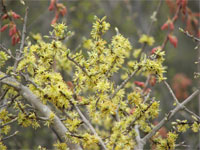
Spring herald (Foresteria pubescens)
Spring herald (Foresteria pubescens), covered in its tiny yellow flowers, forms small thickets along the fence lines, largely unappreciated by mankind for toughness, beauty, and critical supply of rare, late-winter nectar to bees and other insects. Also called elbowbush, for its unique branching habit, this native shrub is “dioecious,” which means having separate male and female plants. The flowers also lack petals (which is not uncommon in nature, but always seems to shock and disappoint people), so the tightly packed inflorescences consist of either stamens (male) or pistils (female) that, from a distance, look a bit like a golden mist upon the stems.
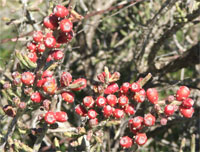
Pencil cactus (Opuntia leptocaulis)
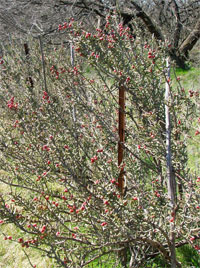
Pencil cactus along a fencerow
A few miles up the road, I see bright red dots among some rather prickly looking stems. A few years ago, when my eyes focused better, I could have probably ID’d the plant at 60 mph. Not any more, so I pull into a farm apron and turn around. (An “apron” is that indention that a fence makes at a farm gate, which allows you to pull your truck and trailer completely off the road while you open the gate. — Thanks to Thresea Tabor.) At first, I thought they might be agarita fruits, but it seemed odd that they would be this far north. As I got closer, I saw that they were indeed fruits, but on native pencil cactus.
Now I’ve always called this plant (Opuntia leptocaulis) a pencil cactus or tasajillo, but it has a bunch of other names, from the elegant desert Christmas cactus to the rather nasty rat-tail. I actually bought and cultivated one of these when I was about 20 years old. My memory of the whole year-long, rat-tailed event is a little fuzzy, but I specifically recall bleeding profusely while trying to move it from the back porch to chuck it over the fence, so I could finally rid myself of its orneriousness (don’t tell me that’s not a word … I’m on a roll here). In spite of my repeated use of specifically instructive scatology, it hung onto me like a tabby cat in a room full of rottweilers. Yes, I was wearing gloves … but also shorts. Flinging it away with my right hand, it would somehow snag and swing around to embed itself in my leg. After a screaming extraction (me, not the plant), I would try the left hand … only to repeat the performance in reverse.
Flexible as a rubber band and covered with 2-inch-long spines, that blasted thing stabbed, poked, and punctured me till I was laid out flat on the ground, exhausted, whimpering, and covered with little streaks of blood. As life would have it, the situation got even worse. When I looked up, I discovered several neighbors had come outside to see what all the commotion was about. Jimmy, the graveyard shift grocery stocker, finally broke the awkward silence with, “I woulda used barbecue tongs,” and they all laughed themselves silly. At the time, I did not find this particularly amusing. Three decades later, still no chuckle.
So … after this flashback goes through my head, I decide it is time to end this injustice. I tinkle on the cactus and head out for the restaurant. Funny … now I’m chuckling. Some time passes before I realize that I have stopped plant hunting … and forgotten what road I am on. Oh, how bad could it be? Can you ever really get lost anymore? I mean, sooner or later, you’re going to hit a town or a four lane. (Dear Reader — this rationale does not apply to West Texas.) Hmmm … wonder what I missed. Fortunately, just ahead there’s a nice thicket of wild plum. What a beautiful sight … think I’ll stop and take a few photos. To tell you the truth, it could be Chickasaw plum, or Oklahoma plum, or hog plum — it’s hard to tell from just the flowers, but I’m guessing it’s Chickasaw plum (Prunus angustifolia) by the zig-zagging twigs. (“Would a hog plum by any other name not taste as sweet?” — Willie Shakespeare)
I put the pedal to the metal so the yummy can hit the tummy. Charles and Mike are already yakkin’ and yukkin’ it up by the time I arrive. The toast is made under the gaze of Elvis, from the 50-plus album covers on the wall. The talk is of wine and roses, literally, for a few moments before we launch into stories … riding motorcycles through the Italian Dolomites (21 hairpin turns in 8 kilometers); savoring a six-hour, $1,000-per-person dinner in a Parisian restaurant (no tip was required); dueling a four-spurred rooster with a PVC pipe; debating the curse of the southeast U.S. garden; trying to finagle a sip from a $9,000 bottle of wine; giving a diamond ring to a waitress (OK, it was a CZ); drinking an Austrian wine that tasted like oysters (which was a good thing); testing Michael Pollen’s theory of plants using people; the girl who smoked a cigarette who was only interesting because she smoked a cigarette; the man with two thumbs on his right hand; schpriken-schpraken-schpeakin’ Germans and the Autobahn; South Africa’s mega-biodiversity; every Texan’s right to free French wine for life because of Thomas Volney Munson (Google him); giant batholiths so round that there is a point where the hiker just falls off; why a 58-year-old should never complain about aging to a 74-year-old (“Ah! to be 58 again!”); dummkopfs for dummies; and why a fine wine can never really be enjoyed. (“If it cost enough to be fine wine, who could enjoy it knowing you paid that much?!?”).
Who said what shall remain a secret in an attempt to protect the innocent. Yes, I said the innocent.
Peace and love,
Steven
About the author: Steven Chamblee is the chief horticulturist for Chandor Gardens in Weatherford and a regular contributor to Neil Sperry’s GARDENS magazine and e-gardens newsletter. Steven adds these invitations:
CHANDOR GARDENS welcomes spring with Spring Fling Weekend
Saturday, April 3, 9 a.m. – 6 p.m.
A special presentation of Alice in Wonderful Chandor Gardens, performed by Theatre Off the Square, 1-4 p.m.
A concert on the lawn by national award-winning singer-songwriter John Tracy, 4-6 p.m.
"Ask a Master Gardener" booth featuring Parker County Master Gardeners, all day.
Saturday admission: $10 adults. $5 ages 6-18; free for 5 and under.
Easter Sunday, April 4, 1 – 4 p.m.
Admission prices just $1 per person, the original amount it cost to tour the garden more than 30 years ago. Come stroll the garden in your Easter finery and take beautiful family photos.
Regular visiting hours
Saturdays 9 a.m. – 3 p.m., and Sundays noon – 4 p.m. For weekday visits, please call first: 817-613-1700 (main office) or 817-598-4029 (Steven’s office). Click here for Spring Fling details.

